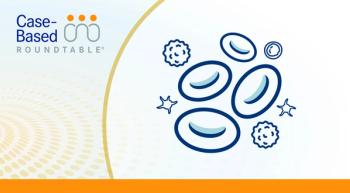
Safety of Carfilzomib Combinations Confirmed in Multiple Myeloma
Consistent benefit was seen with carfilzomib (Kyprolis)-based regimens across subgroups of patients with multiple myeloma in the ASPIRE and ENDEAVOR trials, according to updated safety data reported at the 2018 SOHO Annual Meeting.
Rafat Abonour, MD
Consistent benefit was seen with carfilzomib (Kyprolis)-based regimens across subgroups of patients with multiple myeloma in the ASPIRE and ENDEAVOR trials, according to updated safety data reported at the 2018 SOHO Annual Meeting.
In this post-hoc subgroup analysis of the ASPIRE and ENDEAVOR studies, Rafat Abonour, MD, medical director of the Bone Marrow Transplant Program and the Stem Cell Laboratory at Indiana University School of Medicine, noted that he and his fellow investigators observed improvements in progression-free survival (PFS), and responses were consistent regardless of prior autologous stem cell transplant (ASCT).
In ASPIRE, there was a significant 7.9-month improvement in median overall survival (OS) for carfilzomib, lenalidomide (Revlimid), and dexamethasone (KRd) versus lenalidomide plus dexamethasone (Rd). Median OS for the regimens were 48.3 versus 40.4 months, respectively (hazard ratio [HR], 0.79; 95% CI, 0.67-0.95].1Median PFS was improved by 8.7 months for patients treated with KRd versus Rd, 26.3 versus 17.6 months, respectively (HR, 0.69; 95% CI, 0.57-0.83).2
In ENDEAVOR, carfilzomib was given at a dose of 56 mg/m2plus dexamethasone (Kd56), and compared with bortezomib (Velcade) plus dexamethasone (Vd). Investigators observed a significant 7.6-month improvement in median OS with Kd56 over Vd, 47.6 versus 40.0 months, respectively (HR, 0.79; 95% CI, 0.65-0.96).3Median PFS for Kd56 was 18.7 months compared with 9.4 months for Vd (HR, 0.53; 95% CI, 0.44-0.65).4
“In ASPIRE, patients with prior ASCT treated with KRd had an 11.4-month improvement in median OS and, for those with first relapse after ASCT, the benefit was further pronounced with an 18.6-month improvement in median OS,” said Abonour. “In ENDEAVOR, OS benefits were observed for Kd56 versus Vd across ASCT subgroups; the benefit of Kd was more evident in the no prior transplant group.”
Safety results showed that discontinuation rates due to adverse events (AEs) were similar for the KRd regimen versus Rd across ASCT subgroups. All other AEs were consistent with what has been seen with carfilzomib, noted Abonour.
Of the patients on the ASPIRE trial who received prior ASCT to KRd (n=215), 99.5% experienced AEs of any grade, 89.8% experienced grade ≥ 3 AEs, but only 14.9% discontinued treatment due to AEs. All 87 patients who received KRd after first relapse following ASCT experienced AEs of any grade, 92% experienced grade ≥ 3 AEs, and 27.6% discontinued treatment due to AEs. For those who had no prior ASCT (n=177) and received KRd, 96% experienced AEs of any grade, 83.6% experienced grade ≥3 AEs, and 24.3% discontinued treatment due to AEs. These were comparable to rates of AEs observed with Rd, investigators noted.
The grade ≥3 AEs of interest in the ASPIRE trial for patients receiving KRd versus Rd with prior ASCT were comparableanemia (18.6% vs 17.4%), thrombocytopenia (20.9% vs 14.3%), and neutropenia (36.3% vs 30.8%). For those who received KRd versus Rd after first relapse following frontline ASCT, there were again comparable rates of anemia (17.2% vs 20.8%). thrombocytopenia (17.2% vs 16.9%), and neutropenia (32.3% vs 24.7%). For patients who had not received prior ASCT, rates of anemia (18.6% vs 17.6%), thrombocytopenia (11.9% vs 11.5%), and neutropenia (24.9% vs 23.0%), were similar as well.
Across the subgroups of patients enrolled in the ENDEAVOR trial who received Kd56 or Vd, AEs were similarly comparable to each other. Of the patients who had received prior ASCT and who received Kd65 (n=266), 98.9% experienced AEs of any grade, while 81.6% experienced grade ≥3 AEs, and 28.6% discontinued treatment due to AEs. For those that received Kd65 after first relapse following ASCT (n=123), 98.4% experienced AEs of any grade, 78.0% experienced grade ≥3 AEs, and 26.0% discontinued treatment due to AEs. Lastly, of those who had no prior ASCT and received Kd56 (n=197), 98.5% experienced AEs of any grade, 81.2% experienced grade ≥3 AEs, and 28.9% discontinued treatment due to AEs.
The grade ≥3 AEs of interest in the ENDEAVOR trial for patients receiving Kd56 versus Vd were also comparable in the group that received prior ASCTanemia (16.9% vs 8.2%), thrombocytopenia (10.2% vs 11.6%), and neutropenia (3.4% vs 2.6%). Varying rates of AEs were observed for those who received Kd65 versus Vd after first relapse following ASCT, anemia (13.0% vs 5.8%), thrombocytopenia (4.9% vs 10.8%), and neutropenia (1.6% vs 1.4%). Lastly for those with no prior ASCT, AEs were comparable in those that received Kd56 versus Vd—anemia (15.7% vs 12.8%), thrombocytopenia (7.1% vs 6.4%), and neutropenia (1.0% versus 1.6%).
“Updated safety data from these 2 phase III trials are consistent with previous reports, and indicate that carfilzomib is well tolerated regardless of ASCT status,” concluded Abonour.
References:
- Siegel DS, Dimopoulos MA, Ludwig H, et al. Improvement in overall survival with carfilzomib, lenalidomide, and dexamethasone in patients with relapsed or refractory multiple myeloma.J Clin Oncol.2018;36(8):728-734. doi: 10.1200/JCO.2017.76.5032.
- Stewart AK, Rajkumar V, Dimopoulos MA, et al; ASPIRE Investigators. Carfilzomib, lenalidomide, and dexamethasone for relapsed multiple myeloma.N Engl J Med. 2015; 372(2):142-15 doi: 10.1056/NEJMoa1411321
- Dimopoulos MA, Goldschmidt H, Niesvizky R, et al. Carfilzomib or bortezomib in relapsed or refractory multiple myeloma (ENDEAVOR): an interim overall survival analysis of an open-label, randomised, phase 3 trial.Lancet Oncol. 2017;18(10):1327-1337. doi: 10.1016/S1470-2045(17)30578-8.
- Dimopoulos MA, Moreau P, Palumbo A, et al; ENDEAVOR Investigators. Carfilzomib and dexamethasone versus bortezomib and dexamethasone for patients with relapsed or refractory multiple myeloma (ENDEAVOR): a randomised, phase 3, open-label, multicentre study.Lancet Oncol. 2016;17(1):27-38. doi: 10.1016/S1470-2045(15)00464-7.








































